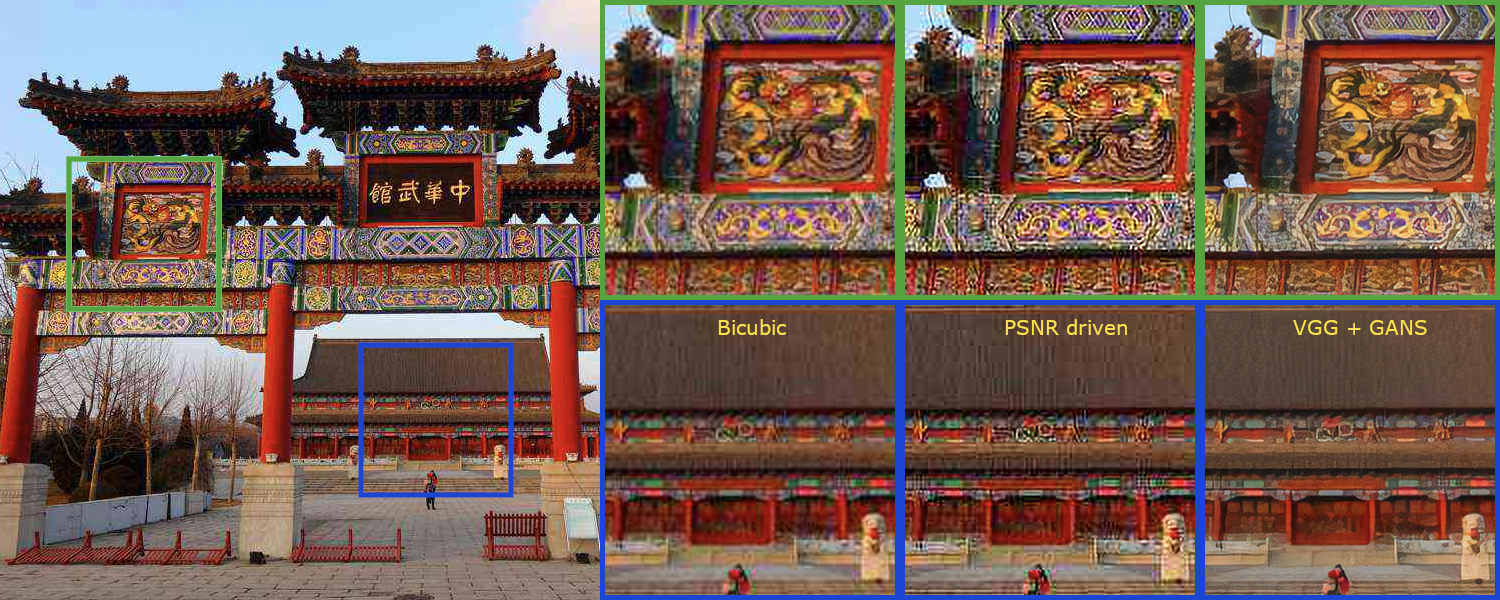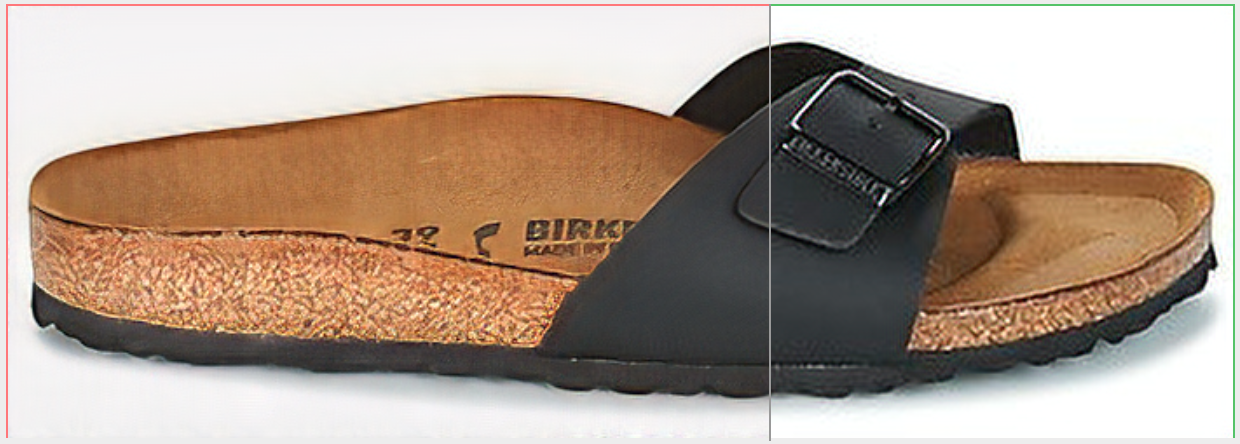The goal of this project is to upscale and improve the quality of low resolution images.
This project contains Keras implementations of different Residual Dense Networks for Single Image Super-Resolution (ISR) as well as scripts to train these networks using content and adversarial loss components.
The implemented networks include:
- The super-scaling Residual Dense Network described in Residual Dense Network for Image Super-Resolution (Zhang et al. 2018)
- The super-scaling Residual in Residual Dense Network described in ESRGAN: Enhanced Super-Resolution Generative Adversarial Networks (Wang et al. 2018)
- A multi-output version of the Keras VGG19 network for deep features extraction used in the perceptual loss
- A custom discriminator network based on the one described in Photo-Realistic Single Image Super-Resolution Using a Generative Adversarial Network (SRGANS, Ledig et al. 2017)
Read the full documentation at: https://idealo.github.io/image-super-resolution/.
Docker scripts and Google Colab notebooks are available to carry training and prediction. Also, we provide scripts to facilitate training on the cloud with AWS and nvidia-docker with only a few commands.
ISR is compatible with Python 3.6 and is distributed under the Apache 2.0 license. We welcome any kind of contribution. If you wish to contribute, please see the Contribute section.
- Pre-trained networks
- Installation
- Usage
- Additional Information
- Contribute
- Citation
- Maintainers
- License
When training your own model, start with only PSNR loss (50+ epochs, depending on the dataset) and only then introduce GANS and feature loss. This can be controlled by the loss weights argument.
This is just sample, you will need to tune these parameters.
PSNR only:
loss_weights = {
'generator': 1.0,
'feature_extractor': 0.0,
'discriminator': 0.00
}
Later:
loss_weights = {
'generator': 0.0,
'feature_extractor': 0.0833,
'discriminator': 0.01
}
If you are having trouble loading your own weights or the pre-trained weights (AttributeError: 'str' object has no attribute 'decode'), try:
pip install 'h5py==2.10.0' --force-reinstallThe weights used to produced these images are available directly when creating the model object.
Currently 4 models are available:
- RDN: psnr-large, psnr-small, noise-cancel
- RRDN: gans
Example usage:
model = RRDN(weights='gans')
The network parameters will be automatically chosen. (see Additional Information).
RDN model, PSNR driven, choose the option weights='psnr-large' or weights='psnr-small' when creating a RDN model.
 |
|---|
| Low resolution image (left), ISR output (center), bicubic scaling (right). Click to zoom. |
RRDN model, trained with Adversarial and VGG features losses, choose the option weights='gans' when creating a RRDN model.
 |
|---|
| RRDN GANS model (left), bicubic upscaling (right). |
| -> more detailed comparison |
RDN model, trained with Adversarial and VGG features losses, choose the option weights='noise-cancel' when creating a RDN model.
 |
|---|
| Standard vs GANS model. Click to zoom. |
 |
|---|
| RDN GANS artefact cancelling model (left), RDN standard PSNR driven model (right). |
| -> more detailed comparison |
There are two ways to install the Image Super-Resolution package:
- Install ISR from PyPI (recommended):
pip install ISR
- Install ISR from the GitHub source:
git clone https://github.com/idealo/image-super-resolution
cd image-super-resolution
python setup.py install
Load image and prepare it
import numpy as np
from PIL import Image
img = Image.open('data/input/test_images/sample_image.jpg')
lr_img = np.array(img)Load a pre-trained model and run prediction (check the prediction tutorial under notebooks for more details)
from ISR.models import RDN
rdn = RDN(weights='psnr-small')
sr_img = rdn.predict(lr_img)
Image.fromarray(sr_img)To predict on large images and avoid memory allocation errors, use the by_patch_of_size option for the predict method, for instance
sr_img = model.predict(image, by_patch_of_size=50)
Check the documentation of the ImageModel class for further details.
Create the models
from ISR.models import RRDN
from ISR.models import Discriminator
from ISR.models import Cut_VGG19
lr_train_patch_size = 40
layers_to_extract = [5, 9]
scale = 2
hr_train_patch_size = lr_train_patch_size * scale
rrdn = RRDN(arch_params={'C':4, 'D':3, 'G':64, 'G0':64, 'T':10, 'x':scale}, patch_size=lr_train_patch_size)
f_ext = Cut_VGG19(patch_size=hr_train_patch_size, layers_to_extract=layers_to_extract)
discr = Discriminator(patch_size=hr_train_patch_size, kernel_size=3)Create a Trainer object using the desired settings and give it the models (f_ext and discr are optional)
from ISR.train import Trainer
loss_weights = {
'generator': 0.0,
'feature_extractor': 0.0833,
'discriminator': 0.01
}
losses = {
'generator': 'mae',
'feature_extractor': 'mse',
'discriminator': 'binary_crossentropy'
}
log_dirs = {'logs': './logs', 'weights': './weights'}
learning_rate = {'initial_value': 0.0004, 'decay_factor': 0.5, 'decay_frequency': 30}
flatness = {'min': 0.0, 'max': 0.15, 'increase': 0.01, 'increase_frequency': 5}
trainer = Trainer(
generator=rrdn,
discriminator=discr,
feature_extractor=f_ext,
lr_train_dir='low_res/training/images',
hr_train_dir='high_res/training/images',
lr_valid_dir='low_res/validation/images',
hr_valid_dir='high_res/validation/images',
loss_weights=loss_weights,
learning_rate=learning_rate,
flatness=flatness,
dataname='image_dataset',
log_dirs=log_dirs,
weights_generator=None,
weights_discriminator=None,
n_validation=40,
)Start training
trainer.train(
epochs=80,
steps_per_epoch=500,
batch_size=16,
monitored_metrics={'val_PSNR_Y': 'max'}
)You can read about how we trained these network weights in our Medium posts:
- part 1: A deep learning based magnifying glass
- part 2: Zoom in... enhance
The weights of the RDN network trained on the DIV2K dataset are available in weights/sample_weights/rdn-C6-D20-G64-G064-x2/PSNR-driven/rdn-C6-D20-G64-G064-x2_PSNR_epoch086.hdf5.
The model was trained using C=6, D=20, G=64, G0=64 as parameters (see architecture for details) for 86 epochs of 1000 batches of 8 32x32 augmented patches taken from LR images.
The artefact can cancelling weights obtained with a combination of different training sessions using different datasets and perceptual loss with VGG19 and GAN can be found at weights/sample_weights/rdn-C6-D20-G64-G064-x2/ArtefactCancelling/rdn-C6-D20-G64-G064-x2_ArtefactCancelling_epoch219.hdf5
We recommend using these weights only when cancelling compression artefacts is a desirable effect.
The main parameters of the architecture structure are:
- D - number of Residual Dense Blocks (RDB)
- C - number of convolutional layers stacked inside a RDB
- G - number of feature maps of each convolutional layers inside the RDBs
- G0 - number of feature maps for convolutions outside of RDBs and of each RBD output
source: Residual Dense Network for Image Super-Resolution
The main parameters of the architecture structure are:
- T - number of Residual in Residual Dense Blocks (RRDB)
- D - number of Residual Dense Blocks (RDB) insider each RRDB
- C - number of convolutional layers stacked inside a RDB
- G - number of feature maps of each convolutional layers inside the RDBs
- G0 - number of feature maps for convolutions outside of RDBs and of each RBD output
source: ESRGAN: Enhanced Super-Resolution Generative Adversarial Networks
We welcome all kinds of contributions, models trained on different datasets, new model architectures and/or hyperparameters combinations that improve the performance of the currently published model.
Will publish the performances of new models in this repository.
See the Contribution guide for more details.
To bump up the version, use
bumpversion {part} setup.py
Please cite our work in your publications if it helps your research.
@misc{cardinale2018isr,
title={ISR},
author={Francesco Cardinale et al.},
year={2018},
howpublished={\url{https://github.com/idealo/image-super-resolution}},
}- Francesco Cardinale, github: cfrancesco
- Dat Tran, github: datitran
See LICENSE for details.






